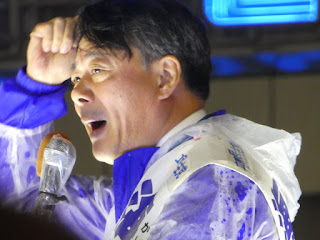I'm not quite wrapping up the year on a personal note. Rather, we have reached that time of the year where various media outlets offer their summaries, their 'one word' that sums up the year in politics and society. In Japan, there are two in particular that are anticipated: the kanji (Japanese/Chinese character) of the year, and the word of the year. I will also add, this year, an award-winning photograph of the year, 'The Okinawa Gaze' (沖縄の視線).
Each of these awards speak to the sense of unease and uncertainty surrounding Prime Minister Abe and his government.
 |
森清範貫主が揮毫した今年の漢字「北」(京都市東山区・清水寺)
Source: Kyoto Shimbun, 12 December 2017
|
Today's announcement of Kanji of the year appeared, initially, a little bland, kita or north, but those who have been watching will be aware of its significance. North Korea. Abe's main vehicle for pressing constitutional revision, and more recently justifying an increase in the defence budget, has been the 'threat' from North Korea's missile program. The judges also noted some 'coincidental' 'north' references: the floods in the northern part of Kyushu, the potato drought in the northernmost island Hokkaido, and a couple of baseball references involving the northernmost team, but the message was pretty clear. North Korea is on the minds of most people who participated in the voting process (other candidates for 2017 included 政 for politics, 不 a prefix indicating un~, or disagreement as in 不支持 'lack of support', where numbers for Abe have been quite high in opinion polls; 核 for nuclear and 新 for new).
The kanji is drawn live on TV and written by revered calligrapher Mori Seihan, Chief Buddhist priest at Kiyomizu Temple in Kyoto. The character remains on display for a few weeks.
The word of the year award, announced a couple of weeks ago was the word sontaku (忖度). It is a word that tends to defy simple definition but it is one of those words that 'when it happens, you know it' as Japanese people seem to translate it. It suggests a request (kind of inferred, but stronger) will be met, without the request (or demand) being formally made (or spoken). It gained popularity during the year in light of a couple of scandals which continue to linger, and which continue to stalk Prime Minister Abe. Both involve educational institutions which have received favourable and extraordinary treatment from the government, implicating in particular Prime Minister Abe and his wife, Akie. The new opposition parties have vowed to continue to seek accountability on these deals in the new year, when parliament returns.
 |
| Taken on 23 June 2017, Sawada Masato Source: Tokyo Shimbun, online, 25 November 2017 |
The third award I will highlight here is the Tokyo photojournalists association award for 'Okinawa Gaze' 沖縄の視線 a photo taken by Tokyo Shimbun cameraman Sawada Masato ( 沢田将人). As someone with an interest in photography, it is a compelling picture and sums up much of the animosity held by people for PM Abe's constitutional push, nowhere more so that the people of Okinawa. The Okinawa story is one which deserves its own blog post (soon) but the island chain, a prefecture of Japan at the southern end of the archipelago, is where Japanese domestic politics, the US Forces bases and Japanese security all intersect and overlap. The people of Okinawa, led by the prefectural governor Onaga Takeshi, mostly resist the construction of new bases but even more so, resent the way in which the Government in Tokyo appears to overrule their wishes in the name of 'national security'. For many in this particular picture, the sight of PM Abe laying a wreath at a ceremony commemorating world war two at the same time as advocating a stronger military, was too great a hypocrisy. The photo captures the anger. Governor Onaga is immediately behind Abe, his gaze unmistakeable.
The puzzles for the new year 2018, for observers such as me, focus on PM Abe, his ambitions and the contradictions inherent in a country that wants to remain at peace, fears the missile threat, doesn't want US bases in Okinawa, but can't be without them either...these awards, this year in particular, struck me as indicative of the mix of belief and ambivalence in Japan this year. I look forward to teasing out the strands next year.
~~~~~~~~~~~~~~~~~~~~~~~~~~~
At the kind invitation of the editor Daniel Flitton, I will be writing a few articles for the Interpreter, part of the Lowy Institute stable of foreign policy and security commentary from an Australian perspective. A recent piece on PM Abe is here.
The puzzles for the new year 2018, for observers such as me, focus on PM Abe, his ambitions and the contradictions inherent in a country that wants to remain at peace, fears the missile threat, doesn't want US bases in Okinawa, but can't be without them either...these awards, this year in particular, struck me as indicative of the mix of belief and ambivalence in Japan this year. I look forward to teasing out the strands next year.
~~~~~~~~~~~~~~~~~~~~~~~~~~~
At the kind invitation of the editor Daniel Flitton, I will be writing a few articles for the Interpreter, part of the Lowy Institute stable of foreign policy and security commentary from an Australian perspective. A recent piece on PM Abe is here.

































